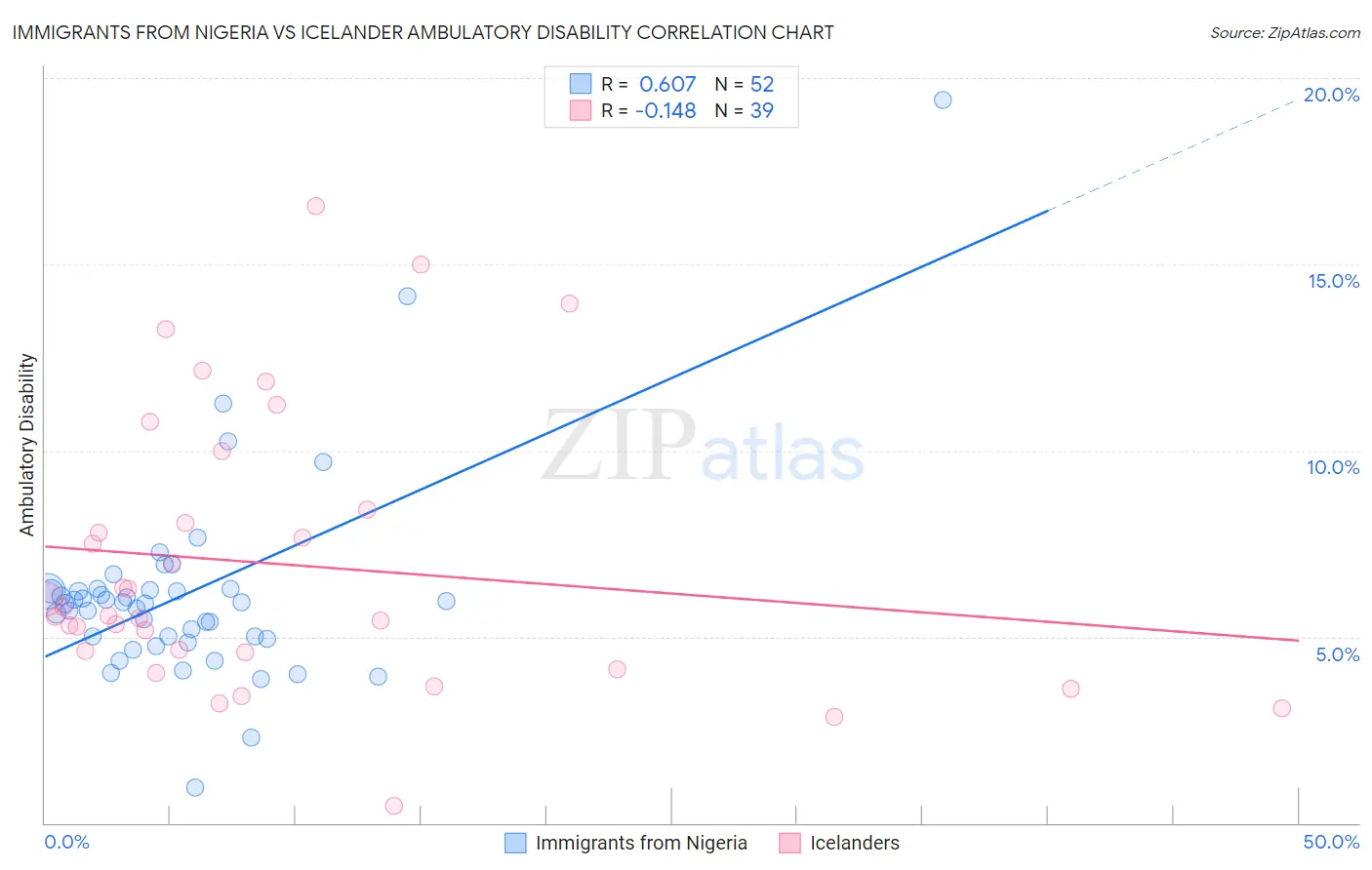Immigrants from Nigeria vs Icelander Ambulatory Disability
COMPARE
Immigrants from Nigeria
Icelander
Ambulatory Disability
Ambulatory Disability Comparison
Immigrants from Nigeria
Icelanders
5.9%
AMBULATORY DISABILITY
90.9/ 100
METRIC RATING
127th/ 347
METRIC RANK
5.9%
AMBULATORY DISABILITY
92.6/ 100
METRIC RATING
122nd/ 347
METRIC RANK
Immigrants from Nigeria vs Icelander Ambulatory Disability Correlation Chart
The statistical analysis conducted on geographies consisting of 283,430,784 people shows a significant positive correlation between the proportion of Immigrants from Nigeria and percentage of population with ambulatory disability in the United States with a correlation coefficient (R) of 0.607 and weighted average of 5.9%. Similarly, the statistical analysis conducted on geographies consisting of 159,642,692 people shows a poor negative correlation between the proportion of Icelanders and percentage of population with ambulatory disability in the United States with a correlation coefficient (R) of -0.148 and weighted average of 5.9%, a difference of 0.30%.

Ambulatory Disability Correlation Summary
| Measurement | Immigrants from Nigeria | Icelander |
| Minimum | 0.93% | 0.47% |
| Maximum | 19.4% | 16.5% |
| Range | 18.5% | 16.1% |
| Mean | 6.2% | 6.9% |
| Median | 5.9% | 5.6% |
| Interquartile 25% (IQ1) | 5.0% | 4.6% |
| Interquartile 75% (IQ3) | 6.2% | 8.4% |
| Interquartile Range (IQR) | 1.3% | 3.8% |
| Standard Deviation (Sample) | 2.8% | 3.7% |
| Standard Deviation (Population) | 2.7% | 3.7% |
Demographics Similar to Immigrants from Nigeria and Icelanders by Ambulatory Disability
In terms of ambulatory disability, the demographic groups most similar to Immigrants from Nigeria are Immigrants from Western Asia (5.9%, a difference of 0.040%), Immigrants from Norway (5.9%, a difference of 0.070%), Arab (5.9%, a difference of 0.10%), Korean (5.9%, a difference of 0.11%), and Immigrants from Kazakhstan (5.9%, a difference of 0.18%). Similarly, the demographic groups most similar to Icelanders are Costa Rican (5.9%, a difference of 0.0%), Immigrants from Russia (5.9%, a difference of 0.020%), Immigrants from Middle Africa (5.9%, a difference of 0.060%), Estonian (5.9%, a difference of 0.070%), and Norwegian (5.9%, a difference of 0.11%).
| Demographics | Rating | Rank | Ambulatory Disability |
| Immigrants | Poland | 95.4 /100 | #114 | Exceptional 5.9% |
| South American Indians | 94.8 /100 | #115 | Exceptional 5.9% |
| Immigrants | Africa | 94.7 /100 | #116 | Exceptional 5.9% |
| Immigrants | South Eastern Asia | 93.6 /100 | #117 | Exceptional 5.9% |
| Russians | 93.4 /100 | #118 | Exceptional 5.9% |
| Norwegians | 93.1 /100 | #119 | Exceptional 5.9% |
| Estonians | 92.9 /100 | #120 | Exceptional 5.9% |
| Costa Ricans | 92.6 /100 | #121 | Exceptional 5.9% |
| Icelanders | 92.6 /100 | #122 | Exceptional 5.9% |
| Immigrants | Russia | 92.4 /100 | #123 | Exceptional 5.9% |
| Immigrants | Middle Africa | 92.2 /100 | #124 | Exceptional 5.9% |
| Koreans | 91.6 /100 | #125 | Exceptional 5.9% |
| Arabs | 91.5 /100 | #126 | Exceptional 5.9% |
| Immigrants | Nigeria | 90.9 /100 | #127 | Exceptional 5.9% |
| Immigrants | Western Asia | 90.7 /100 | #128 | Exceptional 5.9% |
| Immigrants | Norway | 90.5 /100 | #129 | Exceptional 5.9% |
| Immigrants | Kazakhstan | 89.7 /100 | #130 | Excellent 5.9% |
| Immigrants | Costa Rica | 89.5 /100 | #131 | Excellent 5.9% |
| Immigrants | Europe | 87.8 /100 | #132 | Excellent 6.0% |
| Immigrants | Immigrants | 86.9 /100 | #133 | Excellent 6.0% |
| Ute | 86.6 /100 | #134 | Excellent 6.0% |